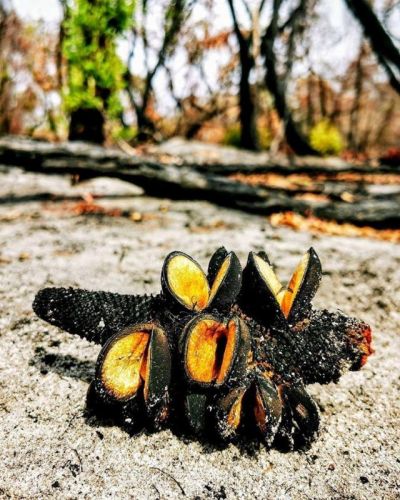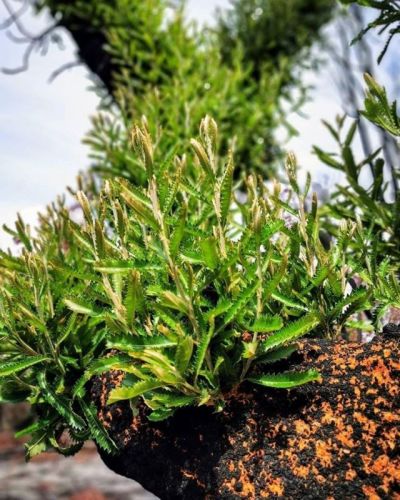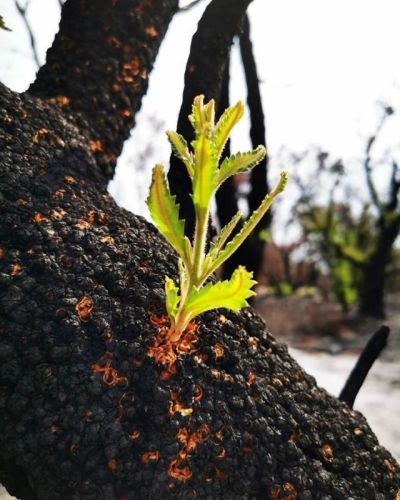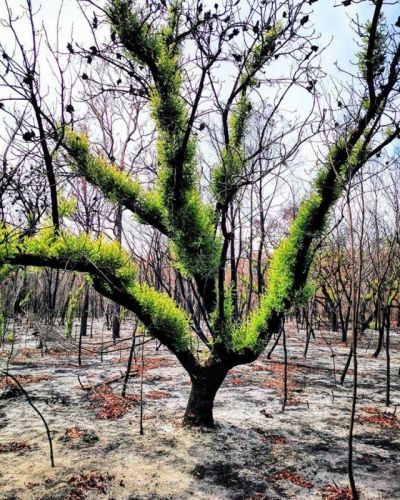
The Australian bush is no stranger to fire. In fact, several species need fire in order to regenerate.
Indigenous Australians have been using fire for thousands of years as a natural part of seasonal cycles and their understanding is invaluable for us to tap into. Unlike hazard reduction burning, cultural burns are cooler and slower moving, usually no taller than knee height, leaving tree canopies untouched and allowing animals to take refuge from the flames. Small fires are lit with matches, instead of drip torches, and burn in a circular pattern.
These burns consider the country. The timing and frequency depend on the geology and therefore soil types, the types of animals and their breeding cycles, the trees and other plants and their flowering cycles. Fire can clear the understorey of a forest to allow room for new seedlings to sprout. And the hollows and fallen logs as a result of fire provide shelter and nests for animals and birds.
Fire can also damage plant and animal communities to such as extent that they may take hundreds of years to recover. Denuding the ground cover can result in erosion once the rain comes. And this also makes the ground vulnerable to weeds and other pests to establish themselves. Another point of vulnerability is the lack of ground cover to protect from predation. Changes in food quality and quantity is another obvious outcome from fires.
The Australian bush has developed amazing strategies to cope after all but the fiercest of fires.

Flora
Fire stimulates many plants to increase productivity and flowering.
Fire is needed for some species to open woody seed pods, releasing the seeds onto the ground, where they encounter fertile ash beds in which to germinate. This process is known as serotiny, where the seed is shielded against a pulse of flame, but then opens to release it. This is common among Banksia species and a number of conifers.
Some plants depend on heat or smoke to germinate seeds in the soil, or to stimulate buds to fruit. Heat-shock can crack open hard shells, liberating seeds or allowing for water to enter. Smoke alone can trigger flowering in some species, and a wave of chemicals released by fire can pass through the soil, both to fertilize and to purge it of toxins. Charcoal acts as a promoter of many annuals. The range of known chemical cues — in air, water, and soil — continues to expand, although many of their mechanisms remain mysterious.
‘Epicormic growth’ is one of the current buzz-words! The epicormic buds of Eucalypts and Banksias are set deep in thick bark which insulates and protects the cambium from heat and damage but fire stimulates regrowth. If there is damage to the crown of the tree, hormones suppressing the sprouts may stop being generated by the crown of the tree, causing the sprouting to occur. This is also true of other species such as Melaleucas (paperbarks) where the surface bark may burn spectacularly but also stimulates growth.
Species such as Eucalypts and Proteaceae also have lignotubers – woody swellings at the base of their stems which contain buds that are dormant until there’s a fire. Some Eucalypts (eg Alpine Ash) don’t survive fire but seeds that are released germinate en masse once conditions are favourable.
Because soil is a good insulator, buds underground are well protected. Plants can survive fires by re-sprouting from basal stems, and also from roots and horizontal rhizomes. Geophytes (plants which have bulbs, corms or rhizomes) survive burning because the storage organs are below ground protected from burning. They persist vegetatively between fires and are stimulated to flower following a fire. Root suckering can result in large clonal populations post-fire.
Many grasses have sheaths around the base that protect them. Tree Ferns (Cyathea australis and Dicksonia antarctica) and Grass Trees (Xanthorrhoea australis) have dense, fibrous trunks. They reshoot and recover quite quickly. Grass Trees rely on fire to remove the buildup of leaves and dead material. Once burnt, flower-spikes, which will develop numerous seeds, are often the first sign that the Grass Tree is alive.
Wattle trees (Acacia species) drop seeds which are stored in the leaf litter and soil, being buried underground by ants busily building up food stores to feed their colonies. The heat of the fire cracks the seedcoats and triggers germination. Acacias may also rely on suckers underground to clone populations.
Nitrogen within a plant is lost to the atmosphere when a plant burns. Nitrogen-fixing bacteria in the root nodules of plants are essential to restore nitrogen, making it available in the soil and for other plants. Many of the first plants that appear after a fire, such as Acacias and pea-flowering plants which are often called 'fire weeds', have this nitrogen converting ability.

Fauna
Animals have the advantage of mobility. Many, such as lizards, are extremely sensitive and detect smoke very quickly. Smoke also awakens Gould's long-eared bats and fat-tailed dunnarts, enabling their escape from fire.
Animals also recognize the distinct sounds of fire. Reed frogs flee towards cover and eastern-red bats wake from torpor when played the crackling sounds of fire.
Other species detect fire for different reasons. Fire beetles from the genus Melanophila depend on fire for reproduction, as their larvae develop in the wood of burned trees. They can detect fire chemicals at very low concentrations, as well as infrared radiation from fires.
Some species of birds that use recently burnt areas for nesting have camouflaged eggs that blend in with the burnt ground and appear less obvious to predators.

It's common to see large animals such as kangaroos and wallabies fleeing a fire, sometimes even doubling back through a fire front to find safety in areas already burned.
Other animals prefer to stay put, seeking refuge in burrows or under rocks. Smaller animals will happily crash a wombat burrow if it means surviving a fire. Burrows buffer animals from the heat of fires, depending on their depth and nearby fuel loads.
From here, animals can repopulate the charred landscape as it recovers. For example, evidence suggests populations of the agile antechinus (a small carnivorous marsupial) and the bush rat recovered primarily from within the footprint of Victoria's Black Saturday fires. Small marsupials such as brown and yellow-footed antechinus also use torpor to suppress their energy use and therefore the need to seek food.
Echidnas are able to burrow into the ground, but can also sustain some burning of their spines. Short-beaked echidnas seek refuge and, when finding it, lower their body temperature and limit activity, so reducing the amount of food they need for energy. Despite their spiny defenses, echidnas have been found more often in the stomachs of foxes following fire, so staying put in a little refuge is a good move.
There isn’t room to document all the diverse and wonderful strategies that God has built into His creation to protect it and ensure species survival. But this gives a taste of some and should be an encouragement for us to realise that these kind of disasters do not catch Him by surprise.

Useful references
https://www.abc.net.au/science/articles/2013/11/04/3882133.htm
https://www.firesticks.org.au/
https://www.nature.com/scitable/knowledge/library/the-ecology-of-fire-13259892/
https://www.environment.gov.au/biodiversity/threatened/publications
http://learnline.cdu.edu.au/units/env207/ecology/ecology.html
https://phys.org/news/2020-01-animals-survive-australia-bushfires.html
https://besjournals.onlinelibrary.wiley.com/doi/abs/10.1111/1365-2745.13227
https://www.degruyter.com/downloadpdf/books/9783110370195/9783110370195-002/9783110370195-002.pdf
https://biology.anu.edu.au/news-events/news/fire-adaptive-traits-eucalpyts
https://www.landcarevic.org.au/assets/Uploads/Burnt-trees-Will-they-regrow.pdf
https://www.dpaw.wa.gov.au/management/fire/fire-and-the-environment/53-fire-plants-and-vegetation

Aira Chilcott is a retired secondary school teacher with lots of science andtheology under her belt. Aira is an editor for PSI and indulges inreading, bushwalking and volunteering at a nature reserve. Aira’s husband Bill passed away in 2022 and she is left with three wonderful adult sons and one grandson.
Aira Chilcott's previous articles may be viewed at http://www.pressserviceinternational.org/aira-chilcott.html